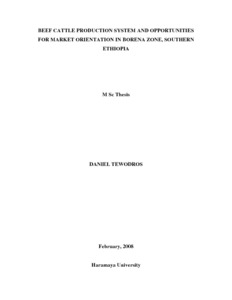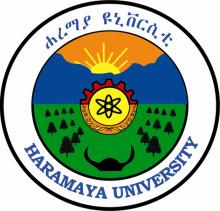Resource information
This study attempted to investigate the beef cattle production system and opportunities for market orientation in southern Ethiopia, Borena Zone. The specific objectives of the study were to characterize cattle production systems, assessment of marketing systems, assess seasonality of domestic cattle meat consumption; and assess potentials and constraints of export abattoirs in Ethiopia. To achieve these objectives, secondary and primary data were used. Export abattoirs, producers, and butcheries interview were sources of primary data. Export abattoirs survey was undertaken on ELFORA Agro- Industries PLC and LUNA export slaughter house PLC. Producers’ survey was done the pastoral areas of Borana Zone of Oromiya Regional State in three Pastoral Associations (PAs) and these were Surupha, Dida Yabello and Dubluk. Producers from each PA were selected using Proportional Probability to Size (PPS) approach for each PA. A total of 150 producers were selected based on the number of households in the PAs. To see the marketing system, four markets were covered from Borena pastoral area (Surupha, Haro Beke, Yabelo, and Dubluk). Butcheries survey was done on the purposively selected areas and these were Kara, Sululta, Dukem and Burayu. Butchery’s from each direction of Addis Ababa were selected using Proportional Probability to Size (PPS). A total of 50 butcheries were selected based on their availability in each of the four areas. To see the seasonality of cattle meat consumption, slaughterhouses which give services to the respective butcheries were covered. According to results of the study, 52.7% of the herd owners keep beef cattle to generate cash income and farming purposes. The major feed resources for 147 (98.6%) of the respondents rely on grass from grazing as a basal feed for their cattle, out of which 54 (36.2%) of them used salt as a supplement. Deep wells are the major sources of water in the study areas. According to the sample households the constraints to cattle production system were shortage of grazing land, water, disease, lack of technical supports, lack of security, labor shortage and conflict. Regarding the market information sources, the majority of the respondents 138 (92%), got market information before they went out to sell their cattle. However, the major sources of market information in the study area were informal. Technical supports on cattle marketing issues were obtained from development/extension agents. For 63.3% of the respondents, the determination of the price at the market places were through negotiation between the sellers/producers and the buyers. About 33% (N=149) of the respondents stated that cattle prices increase during the rainy (wet) seasons, mostly from July to August. The major reasons for the cattle price variation across months/seasons as stated by 114 (76.5 %) of the respondents were the seasonal feed and water availability. The major countries that import beef from Ethiopia are Yemen, Egypt, Congo Brazzaville and Cote D’Ivoire, and the export of beef cattle were either in the form of live or processed meat (chilled or frozen carcass). Thus breed, sex, age, weight and sometimes color of the animal for the live export are the major criteria considered by the live animal exporters xix and export abattoirs during purchase. The major constraints of the export abattoirs were frequent occurrence of livestock diseases, feed and water shortage along export trade routes, market intelligence and transportation. About 84% of the butcheries purchase beef cattle for slaughtering and retailing meat in their butchers. On average, carcass weight of 143.33 ± 5.27 (Mean ± SE) kilogram per head was reported by butcheries, the selling price of a kilogram of beef was 19.36 ± 0.423 ETB (Mean ± SE). However, the price of meat were significantly (P? 0.05) higher 26.00 ±2.041 (Mean ± SE) at Dukem and cattle meat yield were significantly (P? 0.05) higher 164.00 ± 8.95 (Mean ± SE) at Kara as compared to the other locations. The low demand periods for cattle meat correspond with the period of religious fasting periods by the Ethiopian Orthodox Church followers, the slaughter houses cease or minimize their services due to the fact that butcheries stop ordering cattle slaughter services. The constraints of the butcheries were high tax rates, slaughterhouses problems, high price of cattle at the markets and the illegal backyard slaughtering practices. The overall finding of the study underlined the high importance of institutional support in the areas of market oriented cattle production system, market extension, animal health services and range development in the pastoral area, development of export abattoirs facilities, reducing multiple taxes. Therefore, development interventions should give emphasis to improvement of such institutional support system between exporters, butchers and producers, so as to achieve income to these market actors.



